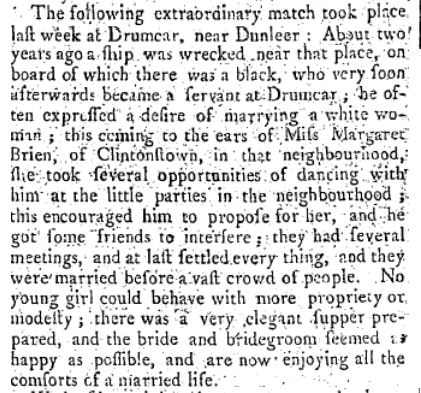|
'Being Sunday my wifes Page the little Tawny Moore was Christened in the church by Mr Bland the minister my son Clifford & Sr Fra. Cobbe being god father and my daughter Anne being godmother'
Burlington Diary, Chatsworth House Archive, Lismore Misc MS, vol. 4, 19 November 1665. The Earl, Richard Boyle (1612-1698) and his wife, Elizabeth Clifford Boyle (1613-1691) were regular visitors to Ireland in this period and it is likely her page accompanied her. The baptism occurred in Yorkshire. In 2020, historian Dr. Ann-Maria Walsh recovered the page's name, Carloe and also that he was aged twelve in 1665. Source Walsh, Ann-Maria, The daughters of the first Earl of Cork: writing family, faith, politics and place (Dublin & Chicago, 2020), p. 104. With thanks to Irish historian Dr. Coleman Dennehy, author of The Irish parliament, 1613-89, editor of Law & Revolution in seventeenth-century Ireland and Restoration Ireland: always settling and never settled and co-editor with Robin Eagles of Henry Bennet, Earl of Arlington, and his World
0 Comments
Sources Freemans Journal 21 Apr. 1785. Hart, W. A., 'Africans in eighteenth-century Ireland' in Irish Historical Studies, 33:129 (May 2002), pp 19-32. Many thanks to Irish historian Dr. Coleman Dennehy, author of The Irish parliament, 1613-89, editor of Law & Revolution in seventeenth-century Ireland and Restoration Ireland: always settling and never settled and co-editor with Robin Eagles of Henry Bennet, Earl of Arlington, and his World
1613 Extract from a letter written by Jesuit priest John Bushlock to the Superior General of the Jesuits, Claudius Aquaviva regarding the Jesuit mission to Ulster in 1613. 'To the bosom of holy Mother Church, two men were added, the conversion of one of whom must certainly not be kept in silence. This man, Indian by nationality (Hic natione Indus), was captured as a three-year-old boy by an English pirate. Hence, in the custom of heretics, he imbibed the errors of Calvin from earliest childhood to such a degree that later as an adolescent he did not think of practicing a religion other than his own sect anywhere. It happened, however, with God permitting, that he stole twelve gold coins from his master and was thus put on trial for his life before judges. But when the matter was understood, our priest managed to get the lord to drop the accusation and spare his life. Immediately he grabbed the opportunity and cultivated the man with the teaching of the Catholic faith and after a few days made him, now renewed by baptism, a member of the Church.' John Bushlock, SJ, to the Very Reverend Father in Christ, Father Claudius Aquaviva, Superior General of the Society of Jesus, 1613; Irish Jesuit Annual Letters, 1604-1674 edit. Vera Moyne (2 vols, Dublin, 2019), vol. I, pp 325-6. In 2002, historian W.A. Hart identified 160 references, mostly in newspapers and memoirs, to African people resident in Ireland in the period 1750-1799. These findings, he continued, suggest the likelihood that there was 2,000-3,000 African people in Ireland. This number is as large as the number of African people in France which had a population four times that of Ireland in the same time period. The Irish references are tantalising. Many of them do not give a name for the person. Terms used to describe the unnamed person vary: 'blackamoor' 'Black' 'sable-skinned' 'Indian' 'black Negro' 'exotic'. Without Census records we often lose sight of the person. It is not uncommon for researchers to come across references to 'African' or 'Indian' people in Ireland whilst engaged in other research. This blog aims to be a repository for these fragmented accounts. It is hoped that over time it may be possible to uncover the names and fate of these 'African' and 'Indian' people in Ireland. Did they remain in Ireland? At least some of them had families in Ireland. What became of their descendants? There are 1870 Census records in South Carolina which give Ireland as the place of birth of people with the racial designation of Black and/or Mulatto. There is much that we do not know. Contributions are welcome from those who have found these fragments and blogs will be amended if and when further information comes to light. Sources Hart, W. A., 'Africans in eighteenth-century Ireland' in Irish Historical Studies, 33:129 (May 2002), pp 19-32. Brennan, Martine, blog to follow re. African Americans in South Carolina with a recorded birth place of Ireland. |
ContributorsMartine Brennan ArchivesCategories
All
|

 RSS Feed
RSS Feed